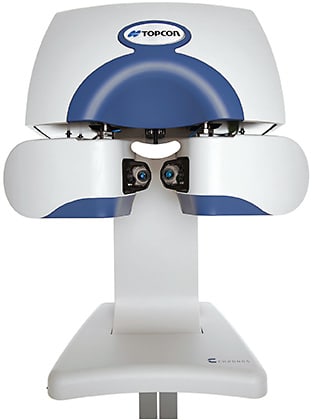Automated binocular refraction system saves ODs clinic time
It makes sense that an automated digital refraction device comprised of autorefraction, keratometry, a phoropter, and an acuity testing chart would be named Chronos. After all, chronos is Greek for time, which is precisely what the device provides to optometrists.
Specifically, in addition to the device’s all-in-one refraction tests, it features a guided refraction software called SightPilot, which shows the operator the entire process of acquiring refractive data, allowing Chronos to be operated by a technician, Topcon says. Other features include control via a browser on one’s tablet or computer to allow for operation from a distance, EHR connectivity, which the company says can streamline the exam and decrease transcription errors, and a footprint of less than 4 square feet, says Topcon.
“When considering where to place the instrument,” Matthew Marisch, OD, who owns and operates 25 optometric practices across Georgia, says, “consider a location with some privacy since you will be talking to the patient throughout the test. You’ll also want to take into account whether other patients will be sharing the space to avoid distractions.”
Dr. Marisch and Justin Bazan, OD, owner of Park Slope Eye, in Brooklyn, N.Y., note the learning curve for staff operation of Chronos is minimal.
Here, Drs. Marisch and Bazan discuss the benefits of their favorite feature of Chronos, delegation.

ADDITIONAL PATIENT TIME
Dr. Marisch says the newfound time provided by Chronos can be spent one-on-one with patients, perhaps discussing the best refractive-correction products, treatment plan, exploring their needs, or answering their questions.
Incidentally, at the completion of the device’s use, the patient’s prior prescription can be entered into Chronos, so they can compare their old prescription to their new one, enabling them to see the difference, which can aid in determining frame and/or contact lens purchases.
“The device could ultimately mean seeing more patients in a day by freeing up the exam lane,” Dr. Marisch notes. “Giving the exam lane time to the doctor to use how he or she wishes is a big deal!”
REMOTE PRESCRIPTIONS
Dr. Bazan says Chronos enables him to assess important refractive information about the patient and formulate the final prescription when he’s not even in the practice.
“I frequently travel abroad. The device allows me to remain engaged with patients, even from afar, as staff can operate it,” he explains. “Also, patients comment on how much they love that we incorporate innovative technology into their exams.”
Optometrists, in general, often remark that new technology can create patient loyalty to a practice.
RELINQUISHING CONTROL
Dr. Marisch emphasizes that the Chronos is for the optometrist willing to give up control of refraction.
“I am willing to let technology take over, but not all doctors are,” he explains. “Even some of my doctors who are using it now were rechecking the results themselves for a while. Now they are very happy with the level of its accuracy.” OM



